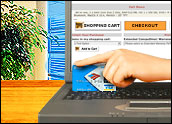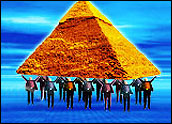
I am an unadulterated, unabashed shopper. I shop online and offline. I window shop, make lists of things I would like to buy, and am on intimate terms with the latest online retailers, from Amazon and Endless.com to Woot.com, eBay and beyond. The frustrations the typical e-commerce sites present when it comes to the checkout line are many, but easily rectifiable.
As the creative director at WhittmanHart Interactive, I also design online shopping platforms for some of the world’s best-known brands. Try as I might to make the online checkout process more seamless and user-friendly, I often can’t get online merchants to budge.
Here is how the standard online shopping experience generally works: I finally find something I like — either through an exhausting search experience where I have to wade through page after page of results because the filtering tools are nonexistent or just plain suck — and I want to add it to my cart. I click the “Add to Cart” button. What happens? I get thrown into some strange place that immediately begins vomiting up other offers for other products, or I get pushed into the checkout process.
This would be akin to going to a brick-and-mortar store, pulling something off the rack and then being teleported to the cash register, surrounded by point-of-sale stands and being asked for your credit card. This is not the experience we expect offline, but it happens everywhere online.
Disorienting Experiences
Very few merchants get it. Target doesn’t get it, Wal-Mart doesn’t get it, and even Amazon doesn’t get it. All of the big online merchants take you through the same disorienting experience. Click “Add to Cart” and boom, I’m no longer shopping, I am suddenly transported somewhere I wasn’t expecting and being cross-sold, up-sold and offered items complete strangers also bought, and I am being pushed to the checkout counter.
Why is this? Well, I have a couple of theories. The first theory is that the old-line merchants are large, publicly traded companies with stockholders to satisfy. These types of companies are often bureaucratic monoliths that trudge along at a snail’s pace when it comes to technology and innovation. Most of them have not fully embraced the online retail experience.
So, often in these companies, you have multiple stakeholders each arguing that their goals are the most important. From the IT department to the marketing department to the merchandisers, you rarely hear any of them talking about the customer as the most important stakeholder. You end up getting design by committee with customers leaving in droves, cart abandonment and average order value declining.
My second theory is that they haven’t done much usability testing on their entire experience, from the first initial contact via a banner ad or search engine results to product selection and finally checkout. Companies often test one part of this experience, but rarely do they examine every touch point.
One reason for this is external agencies and internal groups own different pieces of each, and either don’t have the authority or the budget to test them all. So you might test the actual checkout process but not the 10 other steps it took to get there. It is absolutely critical that you take a holistic approach to the consumer experience.
Companies That Get It
So, who gets it? The Gap gets it, and so do the other members of the Gap family — Old Navy and Banana Republic. They do a great job of keeping the consumer in the moment and in the shopping experience. When you have made your choice and you click to add the item you want, a simple drop-down window appears, confirming your addition.
It casually asks you if you want to proceed to checkout, you are provided a close button on the drop-down, and if you don’t click it, the drop-down slides back up after about 15 seconds. It is a great implementation of a concept I helped develop years ago while at AOL Shopping called “Remember It.”
Remember It allowed you to save items you were interested in that you could later organize, share, delete or purchase. Remember It relaunched last fall as MyLists. Other online retailers offer similar features: Target simply calls them “TargetLists,” and Amazon calls them “Shopping Lists.” However, even these take you out of the shopping experience once you add something to the list. AOL’s version keeps you in the moment, keeps you in the store and keeps you shopping.
Who else gets it? Threadless.com gets it, Diesel gets it, and Lucky Brand Jeans gets it. More and more young hip online retailers are getting “it” everyday. Their audiences have grown up on the Web, so they expect the latest and greatest experience. The good news is that as is often the case with fashion, the larger, older online retailers will mimic the user experiences of these sites and all will benefit.
Eventually, all online retailers will come to grips with this fact: If you deliver a great consumer experience, customers will return. If they become lost, confused or angry during the checkout process, they will leave, tell two friends and never come back.
Disclosure: I am not affiliated with any of the companies or products mentioned in this piece. Instead I’ve chosen to highlight the smart work being done by several great retailers who truly get it.
Andrew Daniel is the creative director at WhittmanHart Interactive, a full-service agency that provides interactive marketing solutions. He joined the company from AOL, where he led product and creative strategy for its Marketplace businesses.















































Social Media
See all Social Media